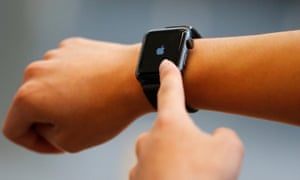Apple’s quarterly results, released on Tuesday, showed the company back on its game. It recorded its highest revenue ever, raking in $78.4bn (£62bn), and also achieved record iPhone sales.
But, as ever, the most interesting points lie below the top line. Apple doesn’t break out much, but what it does can be telling.
1) iPhone is up, up, up
Financially, Apple is a company that makes a phone with few other small businesses on the side. The iPhone represents the lion’s share of the company’s income, which is why it’s good for Tim Cook that sales of the hardware are higher than ever before, with 78.3m units shipped for the three months ending December.
The question for the next year is whether that success will last. This time last year, the unprecedented year-on-year decline in quarterly revenue could be explained by the enormous success of the iPhone 6, and the comparative wet blanket of the iPhone 6s. Now, there is the chance that the 7 looks comparatively good only because the 6s underperformed, so it will take until the first quarter of the next iPhone to really know whether iPhone sales have returned to growth.
2) iPad is … not
But there’s bad news for Apple too. The iPad is in its 13th straight annual decline in unit sales (measured by a four-quarter moving average), from an all-time high of 18.6m in the first quarter of 2014 to the 10.6m units this quarter. (Owing to seasonality, actual units shipped were naturally higher: 13m, down year on year but up on last quarter.) Revenue has been falling too, with $4.8bn pulled in last quarter, compared to an all time high of $8.8bn in the second quarter of 2013 (again, annualised averages).
The release of 9.7in iPad Pro, back in March 2016, provided one piece of good news for the product line, boosting average selling price (it cost $100 more than the iPad Air 2, which it effectively replaced), but that bump has also gone: the average selling price of iPads in the last quarter was the same as it was a year ago.

Almost $5bn of revenue is nothing to be sniffed at, of course, but the decline will prove concerning for Apple, which continues to insist that the iPad is the “future of computing”. The launch of the first iPad Pro, in 2015, was supposed to be Apple’s vision of how we’d all get work done in a post-PC age. That’s looking less and less likely to be true.
Instead, the iPad is taking on a set of characteristics placing it squarely between the iPhone and Mac – as might be expected. Users seen to replace it as rarely as they buy new computers, not as often as they do phones; but they are also finding the devices squeezed from both sides, as computers become more portable and phones become more capable.
3) The Mac, however, is back
For more evidence of that theory, look to the Mac. Unit sales were barely affected by the rise of the iPad, suggesting they weren’t being replaced but were instead being complemented. As the iPad began its decline, Mac sales rose.
But then Apple’s strategy kicked in. The Mac entered a period of neglect, with little new hardware, and some outrageously overlooked product lines, like the Mac Pro (now over three years since it was last updated). Sales declined too, dropping by 500,000 in the period of a year to mid 2016. That would have been fine if users had switched to the iPad – but, of course, they didn’t.
The last quarter, though, saw Apple possibly reversing course. The new MacBook Pro was received with mixed responses (we called it “the best computer you shouldn’t buy”, praising its design and build but criticising its battery life, power, and price), but two things are unquestionably true: it’s an innovative new design, of the sort that is rare in the Mac line; and it costs a bucketload. That latter can be seen in the average selling price of the Mac lineup, which shot back up to levels not seen since early 2013.
4) And then there’s the Apple Watch

Apple doesn’t break out Watch sales. That should be fairly telling in its own right: the product line which the company hoped would be a new plank of the company, alongside the iPhone, iPad and Mac is not doing well enough to take its position in the throne room just yet.
But there are positive signs coming out, despite it all. For one thing, revenue and unit sales just keep rising – though from what, and to what, we don’t know. Average selling price is standing still, though, so it’s not simply that Apple is discounting old stock: and the one baseline we do have, that the Apple Watch outsold every other watch brand save Rolex in 2015, is good news for the future.
Most importantly, everyone save Apple is having a much worse time selling smartwatches. To the extent that there is a smartwatch market, it should really be called the Apple Watch market. It remains to be seen if that’s a market for the long term, but it seems to be one that Apple dominates.
5) And one more thing … services
Then there’s the red-headed stepchild of the Apple revenue streams. “Services” contains hugely disparate businesses, from Apple’s 30% cut on sales on the App Store, to the millions it pulls in through Apple Music, and the combined totals of the £2.49 monthly fees paid for iCloud storage.
Conventional wisdom says that Apple only really runs its service sector to provide reasons to buy the company’s hardware: it’s in the business of selling shiny physical goods, not cloud storage, and so it doesn’t really need to make money on that.
Conventional wisdom may be wrong, though. Apple’s services revenue pulled in $7.2bn in the quarter, an all-time high. That’s more than the total revenue of Facebook, a company with no revenue stream to speak of other than services.
All of which is to say: don’t bet against Apple just yet.

































